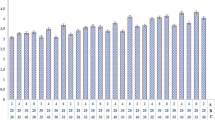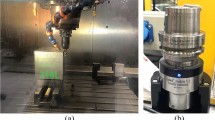Abstract
High-strength steel 2.25Cr–1Mo–0.25V is an important material for making large pressure vessels due to its superior performance. First, study the effect of the interaction between cutting parameters on cutting force and material removal rate (MRR). The central composite response surface method was used to establish the prediction model of cutting force and MRR during the process of turning high strength steel 2.25Cr–1Mo–0.25V. Secondly, the variance analysis method was used to test the predictive model and the significance of each input parameter. The influence of the interaction between cutting parameters on the cutting force and MRR is analyzed, and the accuracy of the prediction model was further verified. Finally, the genetic algorithm is used to obtain the optimal combination of cutting parameters and the minimum cutting force and maximum MRR.








Similar content being viewed by others
References
Özel, T., Hsu, T.K., Zeren, E.: Effects of cutting edge geometry, workpiece hardness, feed rate and cutting speed on surface roughness and forces in finish turning of hardened AISI H13 steel. Int. J. Adv. Manuf. Technol. 25(3–4), 262–269 (2005)
Subramanian, M., Sakthivel, M.: Optimization of cutting parameters for cutting force in shoulder milling of Al7075-T6 using response surface methodology and genetic algorithm. Procedia Eng. 64(12), 690–700 (2013)
Asiltürk, İ., Akkuş, H.: Determining the effect of cutting parameters on surface roughness in hard turning using the Taguchi method. Measurement 44, 1697–1704 (2011)
Nalbant, M., Gökkaya, H., Sur, G.: Application of Taguchi method in the optimization of cutting parameters for surface roughness in turning. Mater. Des. 28(4), 1379–1385 (2006)
Chen, X., Ma, L., Li, C., et al.: Experimental study and genetic algorithm-based optimization of cutting parameters in cutting engineering ceramics. Int. J. Adv. Manuf. Technol. 74(5–8), 807–817 (2014)
Kosaraju, S., Anne, V.G.: Optimal machining conditions for turning Ti–6Al–4V using response surface methodology. Adv. Manuf. 1(4), 329–339 (2013)
Dong, M., Wang, N.: Adaptive network-based fuzzy inference system with leave-one-out cross-validation approach for prediction of surface roughness. Appl. Math. Model. 35(3), 1024–1035 (2010)
Zain, A.M., Haron, H.: Prediction of surface roughness in the end milling machining using fuzzy rule-based. Expert Syst. Appl. 37(2), 1755–1768 (2010)
Zain, A.M., Haron, H., Sharif, S.: Application of GA to optimize cutting conditions for minimizing surface roughness in end milling machining process. Expert Syst. Appl. 37(6), 4650–4659 (2009)
Palanisamy, P., Rajendran, I., Shanmugasundaram, S.: Optimization of machining parameters using genetic algorithm and experimental validation for end-milling operations. Int. J. Adv. Manuf. Technol. 32(7–8), 644–655 (2007)
Mandal, N., Doloi, B., Mondal, B.: Force prediction model of zirconia toughened alumina (ZTA) inserts in hard turning of AISI 4340 steel using response surface methodology. Int. J. Precis. Eng. Manuf. 13(9), 1589–1599 (2012)
Bouacha, K., Yallese, M.A., Mabrouki, T., et al.: Statistical analysis of surface roughness and cutting forces using response surface methodology in hard turning of AISI 52100 bearing steel with CBN tool. Int. J. Refract. Met. Hard Mater. 28(3), 349–361 (2009)
Liao, Y.S., Lin, H.M., Wang, J.H.: Behaviors of end milling Inconel 718 superalloy by cemented carbide tools. J. Mater. Process. Technol. 201, 460–465 (2007)
Chunjing, L., Dunbing, T., Hua, H., et al.: Analysis of surface roughness robustness based on response surface turning. J. Nanjing Univ. Aeronaut. Astronaut. 44(4), 520–525 (2012)
Yongshou, L., Yaoyao, S., Junxue, R., et al.: Research on GH4169 milling force prediction model based on response surface methodology. Mech. Sci. Technol. 29(11), 1547–1552 (2010)
Feng, J., Jiafei, Z., Ying, N., et al.: Optimization of cutting parameters of cemented carbide machining based on response surface methodology. Mech. Des. Res. 4, 112–115 (2015)
Acknowledgements
Thanks to the support of the National Natural Science Foundation of China (51775151).
Author information
Authors and Affiliations
Corresponding author
Additional information
Publisher’s Note
Springer Nature remains neutral with regard to jurisdictional claims in published maps and institutional affiliations.
Rights and permissions
About this article
Cite this article
Zhang, W., Zhang, L., Wang, S. et al. Optimization of machining parameters of 2.25Cr1Mo0.25V steel based on response surface method and genetic algorithm. Int J Interact Des Manuf 13, 809–819 (2019). https://doi.org/10.1007/s12008-018-00525-8
Received:
Accepted:
Published:
Issue Date:
DOI: https://doi.org/10.1007/s12008-018-00525-8




